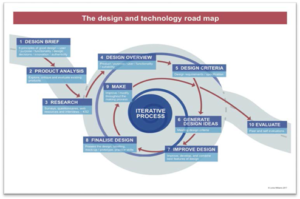The Design and Technology Road Map – A Tool to Support Planning for Future Primary Teachers and Improve Module Formative and Summative Assessment
By Lorna Williams, PGCE Early Years Cohort Lead; School of Education
Figure 1: The Design and Technology Road Map
This case study evaluates excellent practice, linking the UK Professional Standards Framework (2011), aligning to: assessing and providing feedback to learners (A3); developing effective approaches to student support and guidance (A4); and methods for teaching, learning and assessing (K2).
Following the PITE2007 Design and Technology (DT) successes in 2017-18, I sought to add further strength to the module by developing the formative and summative assessment.
I focused upon the importance of constructive alignment system whereby intended learning outcomes, learning and teaching activities and assessment tasks should be carefully calibrated, supporting acquisition of knowledge and skills (Lea, 2015). Meyer et al’s (2010) description of the ‘sandwich model’ helped me to visualise the intended learning outcomes and assessment tasks as the outer layers, with learning and teaching activities forming in the centre. With this in mind, I set about designing the module to enhance the summative and formative assessment.
A common problematic area for students within the assessment was planning a high-quality DT sequence of learning. This needed scaffolding in small steps to strategically support students. The creation of a visual ‘DT planning road map’ specific to the subject, led students through ten generic steps integral in any quality medium-term plan for any age range (Figure 1). Students used this to create a medium-term plan collaboratively. A student commented on it’s usefulness, ‘The plans were really helpful on seeing how a DT sequence of learning is structured.’
Summative assessment involved group presenting plans with an accompanying interactive mini lesson. Student feedback was positive with comments, ‘I found the assessment task useful in creating a medium-term plan and teaching it to the class. By doing this we got the chance to hear other peoples’ and gained confidence in teaching DT ourselves’. To share good practice, these plans were uploaded to Blackboard. Tutor and peer feedback fed forward into the summative assessment – to create an individual DT medium-term plan, complementary prototype resource to demonstrate DT skills and a written justification.
Black and William (1998) concur that formative assessment must be used not only to feedback, but also to support the students to self-evaluate and self-improve. Gibbs (cited in Bryan and Clegg, 2006) asserts that students are strategic in focussing upon what they believe will be assessed. Therefore, assessment needs to frame the learning, with purposeful formative assessments feeding into the summative.
The success within formative assessment saw an increase in students taking the DT assignment, with 55% of students selecting this option from a choice of three subjects in 2018-19. Assignments demonstrated a good level of detail, innovation, clear justification and criticality. Achievement by students was consistently strong with 64% of students achieving grades B or above.
A comparison of student evaluation data between 2017-18 and 2018-19 illuminated the success of the development of assessment. In 2017-18 the statement: ‘The assessment requirements and marking criteria were clear’ had a 97% positive response of which 68% of students strongly agreed. Feedback in 2018-19 saw a rise to 100% of which 97% of students strongly agreed. Again, this positive trend could be demonstrated through the statement: ‘Feedback throughout the module has helped me develop and improve my learning’.
Most notably the impact on my professional practice has been an elevated understanding of the module design. Successes of this module have been recognised and I am now transferring this knowledge to lead a larger Foundation Subjects module in the new revalidated primary undergraduate pathway.
References
Biggs, J. (2014) Constructive alignment in university teaching. Available at: http://www.herdsa.org.au/herdsa-review-higher-education-vol-1/5-22 (Accessed: 6th September 2019).
Black, P. and William, P. (1998) Assessment and classroom learning: Assessment in education, 5(1): 7-74. doi: 10.1080/0969595980050102.
Bryan, C. and Clegg, K. (2006) Innovative Assessment in Higher Education. Oxon: Routledge.
Lea, J. (2015) Enhancing Learning and Teaching in Higher Education: Engaging with the Dimensions of Practice. Berkshire: Open University Press.
Meyer, J.F.H., Land, R. and Baille, C. (2010) Threshold Concepts and Transformational Learning. Rotterdam: Sense Publishers.
UK Professional Standard Framework (UKPSF) (2011) The UK Professional Standards Framework for teaching and supporting learning in higher education. Available at: https://www.heacademy.ac.uk/system/files/downloads/uk_professional_standards_framework.pdf (Accessed: 6th September 2019).


